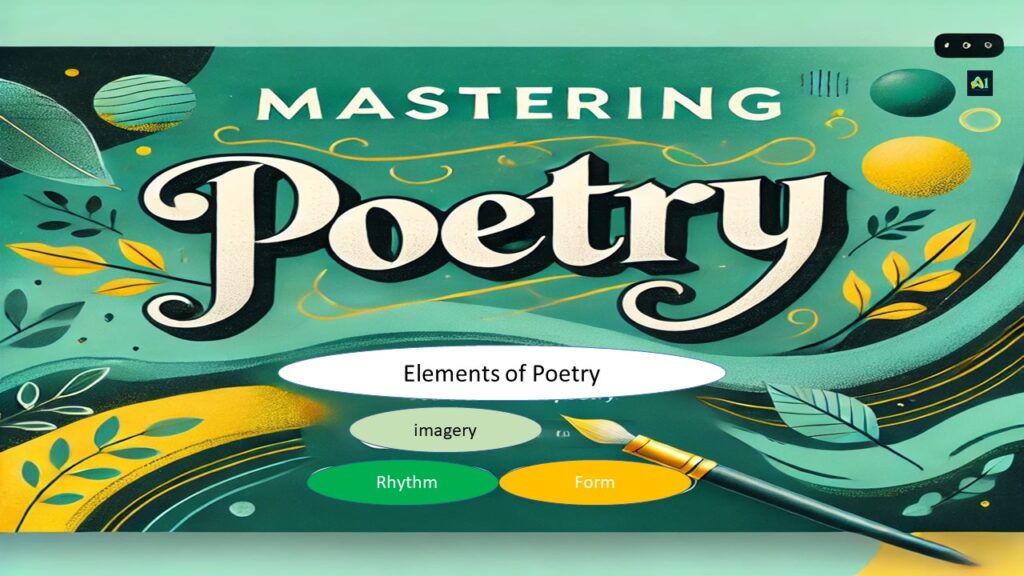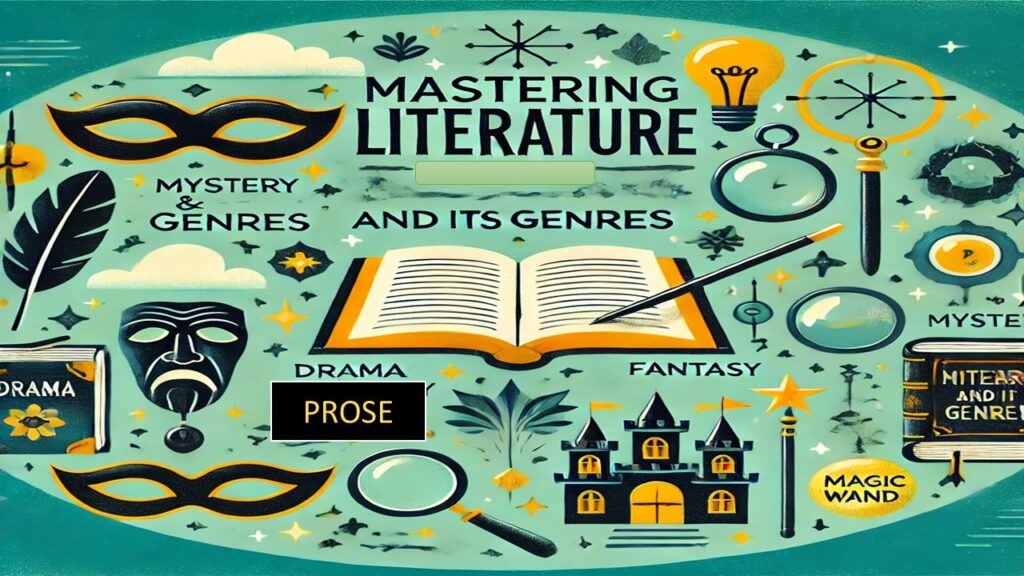A Guide to Mastering Poetry for WAEC and JAMB Exams
Poetry is a literary genre that goes beyond mere words. It captures the depth of human emotions, experiences, and thoughts through carefully chosen language, rhythm, and imagery. Little wonder it is often referred to as the language of the soul. For Students, writers and literature enthusiasts, particularly those preparing for exams like WAEC, NECO, GCE, and JAMB, Mastering poetry will help you appreciating its beauty. You will also be able to master literary analysis. This blog post will walk you the world of poetry. Read along as we explore the definition, characteristics, types, and significance of poetry in literature.
What is Poetry?
Poetry is a form of literary expression that implores rhythmic and often metaphorical language to evoke emotional response and create vivid imagery. Unlike prose, which follows a straightforward narrative structure, poetry is written in verse and stanza. It employs various poetic devices to convey deeper meanings. It can be as simple as a haiku or as complex as an epic, and this makes it a versatile medium for creative expression.
Characteristics of Poetry
Poetry is defined by several unique characteristics that distinguish it from other forms of literature:
- Verse and Stanza Structure: Poetry uses verses and stanzas, similar to sentences and paragraphs in prose. This structure contributes to the rhythm and flow of the poem.
- Economy of Language: poets are able to express deep feelings or evoke strong emotions using only a few words or short lines. Despite the brevity of a poem, the language is carefully chosen to create a lasting emotional impact on the reader
- Imagery and Symbolism: Poetry frequently employs vivid imagery and symbolism to create mental pictures and evoke deeper meanings beyond the literal.
- Rhythm and Meter: Many poems follow a specific rhythmic pattern or meter, which gives them a musical quality and enhances their emotional effect.
- Rhyme and Sound Devices: Poetry makes use of rhyme, alliteration, assonance, and consonance to creates a harmonious effect and reinforces the poem’s meaning and mood.
Elements of Poetry
The following are the elements of poetry:
1. Imagery
Imagery in literature refers to the use of vivid and descriptive language to create mental pictures or sensory experiences for the reader. It appeals to the five senses (sight, sound, smell, taste, and touch) and helps to evoke emotions, set the mood, or enhance the overall experience of the tex. Imageries in poetry are created by means of figures of speech. So, the understanding of these figures will help learners and students taking exams like WAEC NECO and JAMB in getting at the intended meaning of poem. Example:
- Visual imagery: “The golden sun dipped below the horizon, casting a fiery glow over the ocean.”
- Auditory imagery: “The soft whisper of the wind rustled the leaves.”
- Olfactory imagery: “The sweet aroma of blooming jasmine filled the air.”.
2. Rhythm:
In poetry, rhythm is the pattern of beats or sounds in a line. Think of it like the beat of a song—some parts are soft, and some are strong. The strong beats (stressed syllables) and the soft beats (unstressed syllables) create a flow when you read the poem aloud. So, Rhythm refers to the pattern of stressed and unstressed syllables in a line, creating a flow or beat. It gives the poem a musical quality and can help emphasize certain words or themes. Rhythm is important because it contributes to the mood and tone of the poem and enhances the reader’s experience.
Common patterns of rhythm include:
Iambic Rhythm: This is when a soft beat comes first, followed by a strong beat. Example:
In the phrase “I am a boy”, the strong beat (also known as the stressed syllable) falls on the word “boy.” See how the rhythm works:
- “I am a boy” → da-da-da-DUM
- “I,” “am,” and “a” are the unstressed syllables (soft beats or weaker sounds).
- “Boy” is the stressed syllable (the strong beat).
So, the stress is on “boy,” making it the strong beat. This creates an iambic rhythm, where the pattern is soft-soft-soft-strong (da-da-da-DUM).
In Shakespeare’s famous line, “To be or not to be”, we see the iambic rhythm in action. Iambic rhythm follows a soft-strong pattern, with each “soft” syllable followed by a “strong” syllable.
- To be → da-DUM (soft-strong)
- or not → da-DUM (soft-strong)
- to be → da-DUM (soft-strong)
This creates a da-DUM da-DUM da-DUM rhythm, where words like “to” and “or” are unstressed (soft), and words like “be” and “not” are stressed (strong).
Trochaic Rhythm: This is the opposite—starting with a strong beat, followed by a soft beat. This creates a (DUM-da) pattern.
Example 1: William Blake’s The Tyger
“Tyger, Tyger, burning bright”
- Tyger → DUM-da
- burning → DUM-da
- bright → DUM
Example 2: Longfellow’s The Song of Hiawatha
“By the shores of Gitche Gumee”
- By the → DUM-da
- shores of → DUM-da
- Gitche → DUM-da
- Gumee → DUM-da
Each pair of syllables follows the strong-soft (DUM-da) pattern.
In this case, the first syllable of each word (Ty- and burn-) is strong, followed by a softer syllable (-ger and -ing).
3. Rhyme
Rhyme is the matching of sounds, often at the end of lines, or sometimes within lines, in a poem.. Common rhyme schemes include ABAB and AABB. Rhyme creates harmony and can help to link ideas. We shall examine this in detail in a future post.
4. Meter
Meter is the structured pattern of beats or accents that gives rhythm to a poem. It is determined by the number of syllables in each line and the way those syllables are accented (stressed or unstressed). Iambic pentameter (five iambic feet per line) is a common meter in English poetry.
5. Tone
Tone refers to the poet’s attitude toward the subject or the audience. It can be serious, joyful, somber, sarcastic, etc. Tone affects how the reader perceives the poem’s message.
6. Mood
Mood is the state of mind of the poet while writing the poem. It’s how the poem makes the reader feel, influenced by the word choices, imagery, and setting. The mood of the poem determines its tone.
7. Form
The form is the structure or shape of the poem. It includes traditional forms like sonnets, haikus, and odes, or free verse, which doesn’t follow a specific pattern of rhyme or meter.
8. Theme
The theme is the central message or underlying idea of the poem. It reflects the subject matter the poet is exploring, such as love, death, nature, or social issues.
Types of Poetry
This section focuses on the categories of poetry. Poetry is divided into: lyric, Narrative, epic, haiku, free verse, sonnet, ode, dirge, limerick, ballad, and pastoral.
Lyric Poetry:
Lyric poems express personal emotions and thoughts, usually in a musical or rhythmic style. They are typically short and focused on a single theme or feeling. Examples include sonnets, odes, and elegies
- sonnets: This is a type of lyric poem that consists of 14 lines with a specific rhyme scheme and meter. Famous for exploring themes like love and mortality, sonnets are often written in five foot iambic pentameter.
- Odes: These are formal lyric poems that praise or glorify a person, event, or object. They are often lofty in style and reflective in nature.
- Elegies: This is a type of lyric poetry that mourns the loss of someone or reflects on themes of death and sorrow. It’s often meditative and melancholic in tone.
Narrative Poetry:
Narrative poems tell a story, complete with characters, a plot, and a setting. Unlike lyric poetry, narrative poems are often longer and can be similar in structure to short stories or novels. Famous examples include Geoffrey Chaucer’s The Canterbury Tales and Homer’s The Odyssey.
Epic Poetry:
Epic poems are lengthy, grand narratives that celebrate heroic deeds and events of historical or cultural significance. They often involve gods, warriors, and epic battles. Notable examples include The Iliad by Homer and Paradise Lost by John Milton.
Haiku:
A traditional Japanese form of poetry, the haiku consists of three lines with a 5-7-5 syllable structure. Haikus are known for their brevity and focus on nature or a moment of insight.
Free Verse:
Free verse poems do not follow a specific rhyme scheme or meter, allowing poets the freedom to experiment with language and form. This style is popular in modern poetry for its flexibility and expressiveness.
Limerick:
It is a type of humorous poem with five lines; the first two rhymes with the last.
Mastering Poetry for WAEC and JAMB Exams: Let’s see why you should deepen your understanding of poetry.
The Importance of Poetry in Literature and Learning
Poetry is more than just a form of artistic expression; it plays a significant role in literature and education. Here’s why poetry is so important:
- Encourages Creative Thinking: Poetry allows writers to explore language in innovative ways, encouraging creativity and imagination. This can be particularly beneficial for students in developing their own writing styles.
- Enhances Emotional Intelligence: By expressing and exploring complex emotions, poetry helps readers and writers develop empathy and emotional awareness.
- Improves Language Skills: Analyzing and writing poetry can enhance vocabulary, grammar, and comprehension skills. This makes it an excellent tool for language learning.
- Fosters Analytical and Critical Thinking: Understanding poetry requires careful reading and interpretation, which helps students develop analytical and critical thinking skills.
- Cultural and Historical Insight: Poetry often reflects the culture, values, and events of its time. Through it, readers gain insight into different historical periods and perspectives.
Tips for Analyzing Poetry
Analyzing poetry can be challenging, but with the right approach, it can also be deeply rewarding. Below are tips that can help you get started:
- Read the Poem Multiple Times: Read the poem several times to understand its rhythm, tone, and overall message. Each reading can reveal new insights.
- Pinpoint the Theme: Find out the central theme or message of the poem. What is the poet trying to convey?
- Examine the Language and Imagery: Look at the poet’s choice of words, imagery, and symbolism. How do these elements contribute to the poem’s meaning?
- Consider the Structure and Form: Analyze the poem’s structure, including its stanza arrangement, rhyme scheme, and meter. How do these elements affect the poem’s flow and impact?
- Explore the Tone and Mood: Pay attention to the poem’s tone (the poet’s attitude) and mood (the emotional atmosphere). How do these influence your interpretation of the poem?
The Role of Poetry in Exam Preparation
For students preparing for exams such as WAEC, NECO, GCE, and JAMB, understanding poetry is vital. These exams often include sections that test students’ ability to analyze and interpret poems. If you master poetic devices, themes, and forms, this will significantly enhance your performance in literature exams.
Conclusion
Poetry is a unique and powerful form of expression that enriches our understanding of language, culture, and human experience. Whether you are a student preparing for exams, a writer honing your craft, or simply a lover of literature, This article ,”Mastering Poetry for WAEC and JAMB Exams,” will no doubt sharpen your understanding of poetry. By exploring it you can open up new worlds of insight and inspiration. By learning to appreciate and analyze poetry, you can deepen your connection to this timeless art form and unlock its many layers of meaning. Keep mastering poetry!



